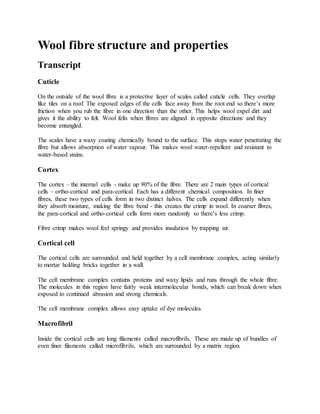
Wool fibre structure and properties
- 1. Wool fibre structure and properties Transcript Cuticle On the outside of the wool fibre is a protective layer of scales called cuticle cells. They overlap like tiles on a roof. The exposed edges of the cells face away from the root end so there’s more friction when you rub the fibre in one direction than the other. This helps wool expel dirt and gives it the ability to felt. Wool felts when fibres are aligned in opposite directions and they become entangled. The scales have a waxy coating chemically bound to the surface. This stops water penetrating the fibre but allows absorption of water vapour. This makes wool water-repellent and resistant to water-based stains. Cortex The cortex – the internal cells - make up 90% of the fibre. There are 2 main types of cortical cells – ortho-cortical and para-cortical. Each has a different chemical composition. In finer fibres, these two types of cells form in two distinct halves. The cells expand differently when they absorb moisture, making the fibre bend - this creates the crimp in wool. In coarser fibres, the para-cortical and ortho-cortical cells form more randomly so there’s less crimp. Fibre crimp makes wool feel springy and provides insulation by trapping air. Cortical cell The cortical cells are surrounded and held together by a cell membrane complex, acting similarly to mortar holding bricks together in a wall. The cell membrane complex contains proteins and waxy lipids and runs through the whole fibre. The molecules in this region have fairly weak intermolecular bonds, which can break down when exposed to continued abrasion and strong chemicals. The cell membrane complex allows easy uptake of dye molecules. Macrofibril Inside the cortical cells are long filaments called macrofibrils. These are made up of bundles of even finer filaments called microfibrils, which are surrounded by a matrix region.
- 2. Matrix The matrix consists of high sulphur proteins. This makes wool absorbent because sulphur atoms attract water molecules. Wool can absorb up to 30% of its weight in water and can also absorb and retain large amounts of dye. This region is also responsible for wool’s fire-resistance and anti-static properties. Microfibril Within the matrix area, there are embedded smaller units called microfibrils. The microfibrils in the matrix are rather like the steel rods embedded in reinforced concrete to give strength and flexibility. The microfibrils contain pairs of twisted molecular chains. Twisted molecular chain and helical coil Within the twisted molecular chains are protein chains that are coiled in a helical shape much like a spring. This structure is stiffened by hydrogen bonds and disulphide bonds within the protein chain. They link each coil of the helix, helping to prevent it stretching. The helical coil – the smallest part of the fibre – gives wool its flexibility, elasticity and resilience, which helps wool fabric keep its shape and remain wrinkle-free in use.
